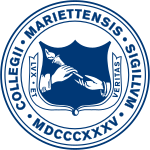Marietta College
| Latin: Collegium Mariettensis | |
| Motto | LUX ET VERITAS |
|---|---|
|
Motto in English
|
Light and truth |
| Type | Private liberal arts college |
| Established | 1835 |
| Endowment | $77.7 million |
| President | William Ruud |
| Provost | Janet L. Bland |
|
Academic staff
|
103 full-time 49 part-time |
| Students | 1,200 |
| Location | Marietta, Ohio, United States |
| Campus | Small Town |
| Colors | Navy Blue, White |
| Athletics | NCAA Division III – OAC |
| Sports | 20 varsity teams |
| Nickname | Pioneers |
| Affiliations | CIC |
| Website | http://www.marietta.edu |
Marietta College (Latin: Collegium Mariettensis) is a co-educational liberal arts private college in historic Marietta, Ohio, USA, (population 14,000+) which was the first permanent settlement of the Northwest Territory. The school offers 45 majors along with a large number of minors, all of which are grounded in a strong liberal arts foundation. The school encompasses approximately three city blocks next to downtown Marietta and enrolls 1,200 full-time students. It is known for its Petroleum Engineering, Athletic Training, McDonough Leadership, and Physician Assistant programs, as well as its China Program.
Historically preceded by the community's Muskingum Academy, established in 1797, today's College was chartered in 1835 and the first president was the Rev. Joel H. Linsley. In the years before the Civil War, its students absorbed the city's ethic of supporting abolitionism. They helped fugitive slaves take shelter at the college, which was used as a station on the Underground Railroad to help slaves reach freedom in northern states or Canada.
Marietta College worked toward high academic achievement. In 1860, it became the sixteenth college awarded a chapter of Phi Beta Kappa, the world's oldest honorary society.
During the Great War, before the United States entered the war, a group of students went to France to serve as the Marietta College Volunteer Ambulance Corps. After the war, France commemorated their service with what is known as the French monument, which it gave to the city of Marietta. The monument has two parts: a replica of a historic 1749 plaque found buried at this site, which noted the French claim to the Ohio Country, and a plaque to commemorate the ambulance corps. The names of the young men who served with the corps are included.
In the 21st century, the majority of the students at the college are from Ohio, Pennsylvania and West Virginia, but a sizable portion of the student population is from the New England states, and Asia.
...
Wikipedia

